Abstract
Numerical simulations of atmospheric dispersion and dose assessment were performed for the Jordan Research and Training Reactor (JRTR) to evaluate its radiological effects on surrounding population and the environment. A three-dimensional atmospheric dispersion model was applied to investigate the behavior of the radionuclides released into the air, and a dose assessment model was used to estimate the radiological impact on the population residing in nearby cities around the JRTR. Considering full core meltdown an accidental scenario, most of the source term was assumed to be released from the JRTR. Simulations were performed to calculate the air and deposition concentrations of radioactive materials for July 2013 and January 2014. The monthly averaged values of concentrations, depositions, and dose rates were analyzed to identify the most harmful effects in each month. The results showed that relatively harmful effects occurred in January 2014, and the total annual dose rate was estimated to be approximately 1 mSv outside the 10 km radius from JRTR. However, the impact of a nuclear accident is not as severe as it might seem, as the affected area is not highly populated, and appropriate protective measures can significantly reduce the radiation exposure. This study provides useful information for emergency preparedness and response planning to mitigate the radiological consequences of a nuclear accident at the JRTR.
1. Introduction
The prompt and accurate evaluation of the environmental and health effects resulting from the release of radioactive materials into the atmosphere during nuclear accidents is crucial for implementing appropriate countermeasures to guarantee the safety of the surrounding population and environment [1]. The severity of these effects can vary widely depending on the release rate and duration of the radioactive materials, which can be transported over long distances and can contaminate wide areas around the accident sites, leading to long-term health problems and environmental damage. Therefore, an extensive environmental hazard assessment was performed to evaluate the potential radiological impact on the population residing in cities surrounding nuclear facilities.
Research reactors are constructed and operated for research and training purposes. They are typically used for the testing and development of nuclear fuel, reactor components, reactor instrumentation, and control systems, as well as for the training and education of personnel. They are also used for radioisotope production in medical and industrial applications. Research reactors operate at relatively low power levels, ranging from kilowatts to a few hundred megawatts [2].
The Jordan Research and Training Reactor (JRTR) was constructed and operated in Jordan in 2016. The JRTR is a 5 MWth (upgradable to 10 MWth) open-pool-type light-water reactor located at the Jordan University of Science and Technology (JUST), 70 km from the capital Amman in Jordan [3]. The JRTR is the first nuclear research reactor in Jordan and the Middle East. It serves as a cornerstone for the development of Jordan’s nuclear programs and is designed for use in three main areas: education and training, advanced nuclear research, and commercial and industrial services centered on radioisotope production [4]. The JRTR specifications are listed in Table 1 [5].

Table 1.
JRTR specifications.
Although the JRTR operates at a lower power level than nuclear power plants, a risk assessment must be conducted to ensure public and environmental safety. In the event of an accident or incident involving a reactor, a large amount of radioactive material is released to the environment. Therefore, radiological hazard assessment is a major concern and requirement for research reactors. This assessment is used to evaluate the potential health risks associated with radiation exposure, and it involves various steps, such as characterization of the source term, evaluation of potential pathways of exposure, determination of potential doses and health effects, and evaluation of mitigation strategies [6,7]. The primary purpose of an environmental hazard assessment is to provide decision makers and stakeholders with information about potential consequences, and to ensure appropriate countermeasures for protecting the public and environment [8].
The JRTR Final Safety Analysis Report (FSAR) [3] and Radiation Environmental Report (RER) [9] identify the flow blockage of a fuel assembly as a limited accident that releases the highest source term to the environment. Another study by Xoubi [10] derived the source term of full core damage, and evaluated the atmospheric dispersion of released radionuclides for a downwind distance of 100 km using HotSpot code, which is a Gaussian plume model. The HotSpot code is a first-order approximation of the radiation effects associated with the atmospheric release of radioactive materials, designed for short-range (less than 10 km), and short-term (less than a few hours) predictions [11].
However, the Gaussian plume model has certain limitations under specific conditions, such as low wind speed, complex terrain, spatial and temporal changes in wind velocity, and deposition and transformation. In contrast, the particle-in-cell (PIC) model can handle the effects of time-varying wind and deposition processes, and incorporate terrain effects directly through adjustments in a three-dimensional grid system [12]. The characteristics of Gaussian plume and Lagrangian models are well described in some application research by the IAEA program [13,14].
In this study, the Hybrid Single-Particle Lagrangian Integrated Trajectory (HYSPLIT) model was applied to evaluate the dispersion patterns of radioactive materials released into the atmosphere and subsequence dose assessment. The HYSPLIT [15] can simulate the three-dimensional concentrations of radionuclides in air and their deposition on the ground due to dry and wet processes. After simulating the dispersion of the radionuclides, the calculated concentrations were utilized for radiological effect assessment in the dose module.
2. Materials and Methods
2.1. Site Location
The JRTR is located within JUST in Irbid City, Jordan. It is located approximately 70 km north of Amman and 13 km southeast of Irbid. The geographical coordinates of the JRTR are 32.4627° N and 35.9730° E. Ground elevations of the site range from 560 m to 635 m [9]. Figure 1 illustrates the JRTR site and prominent cities within a radius of 80 km.
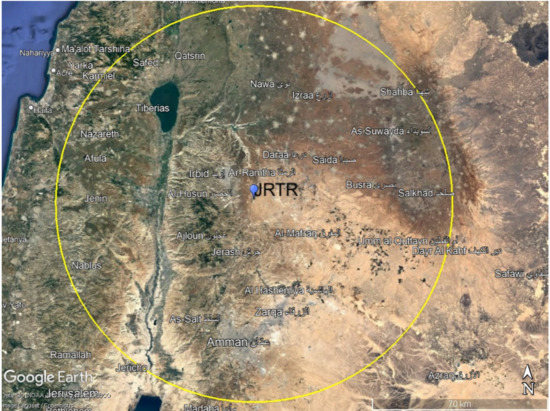
Figure 1.
Location of JRTR and surrounding cities in the radius of 80 km.
The governorates of Irbid, Jarash, Ajlun, and Balqa are entirely situated within the 80 km radius of the JRTR. On the other hand, the governorates of Amman, Zarqa, and Mafraq are partially situated within the 80 km radius, with the majority of densely populated regions falling within this range. Table 2 shows the estimated population of Jordan by governorate at end-year 2013 and 2022 [16,17]. According to the below table, approximately 90% of Jordan’s overall population resides within an 80 km proximity to the JRTR.

Table 2.
Estimated population of Jordan by governorate at end-year 2013 and 2022.
2.2. Atmosperic Dispersion Assessment
The HYSPLIT model was used to calculate air concentrations and ground depositions for a nuclear accident in the JRTR. It is a complete system developed by the U.S. National Oceanic and Atmospheric Administration (NOAA) and is designed for atmospheric dispersion analysis by computing simple trajectories for complex dispersion and deposition simulations using either puff or particle approaches [15]. The input data were interpolated to an internal sub-grid centered to reduce memory requirements and enhance computational speed. The model requires the emission rate and physical characteristics of the pollutants to be defined. The model calculation method is a hybrid between Eulerian and Lagrangian approaches. Advection and diffusion calculations are performed in a Lagrangian framework, while concentrations are calculated in a Eulerian approach. Air concentration and depositions are associated with the mass of pollutant species, such as the release of puffs, particles, or a combination of both. The dispersion of a pollutant is calculated by assuming either a Gaussian or top-hat horizontal distribution within a puff, or from the dispersal of a fixed number of particles.
A Lagrangian model can compute air concentrations through either of two assumptions: puff or particle. In a puff model, the source is simulated by releasing pollutant puffs at regular intervals over the duration of the release. Each puff contains the appropriate fraction of the pollutant mass. The puff is advected according to the trajectory of its center position, while the size of the puff (both horizontally and vertically) expands in time to account for the dispersive nature of a turbulent atmosphere. Air concentrations are then calculated at specific points (or nodes on a grid) by assuming that the concentrations within the puff have a defined spatial distribution. In a Lagrangian particle model, the source can be simulated by releasing many particles over the duration of the release. In addition to the advective motion of each particle, a random component to the motion is added at each step according to the atmospheric turbulence at that time. In this way a cluster of particles released at the same point will expand in space and time simulating the dispersive nature of the atmosphere. Air concentrations are calculated by summing the mass of all the particles in a grid cell.
Dispersion in a Lagrangian model is computed following the particle or puff. The advection of a particle is computed independently of the dispersion calculation. The time integrated advection of each particle can be viewed as a simple trajectory which only requires the three-dimensional velocity field. The velocity fields from meteorological data are processed and interpolated to the internal model grid, and trajectories can be computed to test the advection components of the model. Detailed mathematical formulations of HYSPLIT are available in the literature [15,18,19,20].
2.3. Source Term
The FSAR [3] and RER [9] for JRTR have identified the complete blockage of a fuel assembly as a limited design basis accident that could result in the most significant release of fission products into the environment. Xoubi [10] additionally considered the scenario of one or more projectiles targeting the reactor building, leading to the destruction of the reactor confinement and pool, ultimately causing damage to all fuel assemblies. Given the absence of a containment building and the potential security threats resulting from the current situation in the Middle East, including the JRTR’s proximity to the Syrian borders, a radiological impact assessment was conducted utilizing the source term provided by Xoubi [10].
For the computation of source term at the JRTR, the ORGEN-ARP code was used, and the cross-section library was generated for a JRTR fuel assembly using TRITON in SCALE [3,9,10]. The release fractions of radionuclides during the postulated severe accident were estimated in accordance with the International Atomic Energy Agency (IAEA) [6]. Table 3 lists the source terms released into the environment derived by Xoubi [10].

Table 3.
JRTR source term released to the environment due to a full core destruction by projectiles.
The total period of the accident applied to the dose calculation is assumed to be 31 days after the accident. Fission products in the core are immediately released to the environment following the accident. The release mode for accident is assumed to be a ground release. Noble gases are released in gas form, iodine isotopes released in various forms, including molecular iodine, aerosols, and organic compounds, and other radioactive nuclides are released in aerosol form.
2.4. Meteorological Data
Meteorological normals and extremes for precipitation, humidity, and wind speed at Ramtha Station and wind direction at Irbid Station are shown in Table 4 [9]. The data were based on measurements from 1976 to 2000.

Table 4.
Histological meteorological normals and extremes at Ramatha and Irbid stations near JRTR site between 1976 and 2000.
Radionuclide dispersion proportionally decreased with high humidity and precipitation and increased with the high wind speed, while deposition proportionally increased with high humidity and precipitation and decreased with the low wind speed. Table 4 shows that January had the highest mean precipitation and relative humidity, with a relatively low mean wind speed. Therefore, the release of radioactive materials in January is anticipated to result in the highest radionuclide concentrations in areas near the JRTR site. July had zero precipitation and the highest mean wind speed, which resulted in the dispersion of radionuclides far from the JRTR site.
Radiological hazard assessments in the JRTR FSAR and RER [3,9] were conducted using meteorological data from May 2013 to April 2014. Therefore, in this study, July 2013 and January 2014 were selected to evaluate the atmospheric dispersion and radiological effects of relatively large and small depositions, respectively. The meteorological data required to run the HYSPLIT model were obtained from a data archive consisting of the Global Data Analysis System (GDAS) of NOAA.
2.5. Dose Assessment
Radiation exposure is a major factor in the management of nuclear emergencies. In terms of accuracy and reliability, actual measurements are the optimal strategy for obtaining information concerning the dose received by individuals. However, in practice, obtaining measurements from all individuals affected by nuclear accidents over the entire period of exposure is a major challenge [21]. Therefore, a dose assessment model has been applied to estimate the radiological exposure of the public to a nuclear accident [22]. Radionuclides released to the environment is a potential risk to humans and the environment; therefore, major efforts have been concentrated on developing an internationally acceptable system [23,24,25].
Radiation assessment in humans can be evaluated by considering the exposure pathways. Human exposure to radiation can be classified as external and internal doses. External radiation from radioactive materials directly affects the human body (i.e., high-energy radiation, such as gamma radiation, which penetrates the human body). This radiation can be emitted from facilities, air-suspended radionuclides, or radionuclides deposited on the ground. External exposure is typically the principal route of radioactive effluents released from nuclear plants, whereas internal exposure is caused by inhalation, ingestion, or absorption through intact or broken skin. Ingestion is usually the principal route of radioactive effluent intake. The external and internal exposures can be calculated using the equations described below [22].
Inhalation of radionuclides in the plume:
- HE(inh),i: Effective dose from inhalation (Sv);
- Ca,i(x): Average activity concentration of radionuclide i at location x (Bq/m3);
- Dinh,i: Inhalation dose coefficient (Sv/Bq);
- Iinh: Inhalation rate (m3/a).
External exposure from the cloud:
- HE(ex,cloud),i: Effective dose from external exposure to radionuclide i (Sv);
- Ca,i(x): Time integrated activity concentration of radionuclide i in air at location x (Bq·s/m3);
- D(ex,cloud),i: External dose coefficient for immersion in the cloud (Sv per (Bq·s)/m3);
- Oout: Fraction of time spent outdoors;
- Lcloud: Dimensionless factor considering the shielding effect of buildings.
External exposure from deposited radionuclides:
- HE(ex,deposit),i: Effective dose from deposited radionuclide i (Sv);
- Cs,i(x): Time integrated activity concentration of radionuclide i on soil at location x (Bq·s/m2);
- Dex,deposit: External dose coefficient from the deposit (Sv per (Bq·s)/m2);
- Oout: Fraction of time spent outdoors;
- Ldeposit: Dimensionless factor that considers the shielding effect of buildings.
The calculation of the total effective dose resulting from the release of radionuclides during an accident necessitates the use of dose coefficients. The U.S. Environmental Protection Agency’s Federal Guidance Reports (FGR) [26,27] provided all the necessary dose coefficients for every exposure pathway associated with the released radionuclides.
2.6. Other Input Parameters
HYSPLIT [15] offers three distinct mechanisms for removing pollutants, namely dry deposition, wet depletion, and radioactive decay. Dry deposition is characterized by a deposition velocity (vd) that varies depending on the surface type and isotope. For this study, two deposition velocities were employed: 0.3 cm/s for respirable particles and 8 cm/s for non-respirable particles [10].
Wet depletion encompasses two processes: the first involves the continuous ingestion of polluted air into a cloud from a polluted boundary layer, followed by transportation within the cloud (in-cloud); the second process involves rain falling through a polluted layer (below-cloud). For soluble gases, wet removal is defined by specifying its Henry’s Law constant. Gaseous wet removal occurs only for the fraction of the pollutant that lies below the cloud top. Particle wet removal is defined by a scavenging ratio within the cloud and an explicit scavenging coefficient for pollutants below the cloud base. The relevant values used in this study were obtained from the suggested values in the HYSPLIT user’s guide [28].
3. Results and Discussion
In January, a release of radioactive materials was anticipated to result in the highest radionuclide concentrations in areas surrounding the JRTR site. July had the highest mean wind speed, which resulted in the dispersion of radionuclides far from the JRTR site (Table 4). In particular, simulations were performed in July 2013 and January 2014, which was the period used for the radiological hazard assessment in the JRTR FSAR and RER [3,9].
Figure 2 shows the monthly integrated air concentration map for July 2013, where all the radionuclides listed in Table 3 are assumed to be released into the atmosphere. As demonstrated in Table 4, most radioactive materials in July moved eastward owing to the westerly wind. The GDAS of NOAA in July exhibited similar wind patterns, and the measured wind fields in the JRTR report maintained a constant westerly wind during summer.
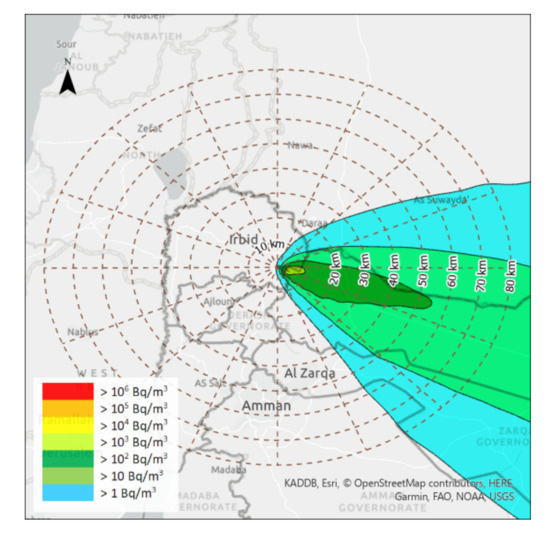
Figure 2.
Integrated air concentration in July 2013.
Figure 3 illustrates the monthly integrated air concentration map in January 2014 and the radioactive materials transported in various directions owing to the complicated wind patterns in winter. The concentrations of radionuclides in the air were relatively higher near the JRTR site in January than in July because they did not disperse widely in various areas in January owing to the relatively large precipitation and low wind speed in winter.
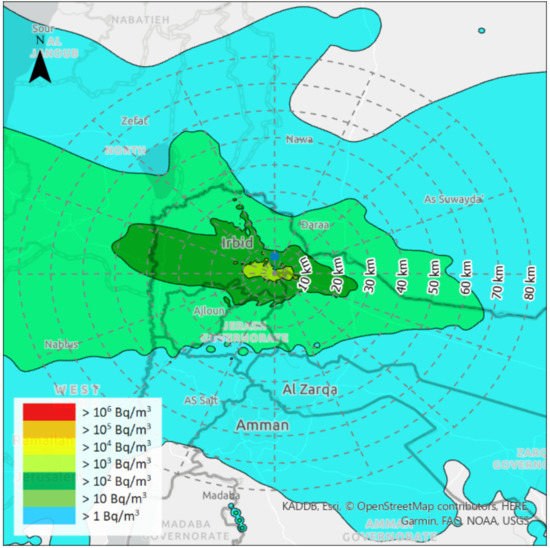
Figure 3.
Integrated air concentration in January 2014.
Figure 4 and Figure 5 depict the total ground deposition in July 2013 and January 2014, respectively. These depositions exhibited the same patterns as the integrated air concentrations illustrated in Figure 2 and Figure 3. More deposits were recorded near the JRTR in January than in July.
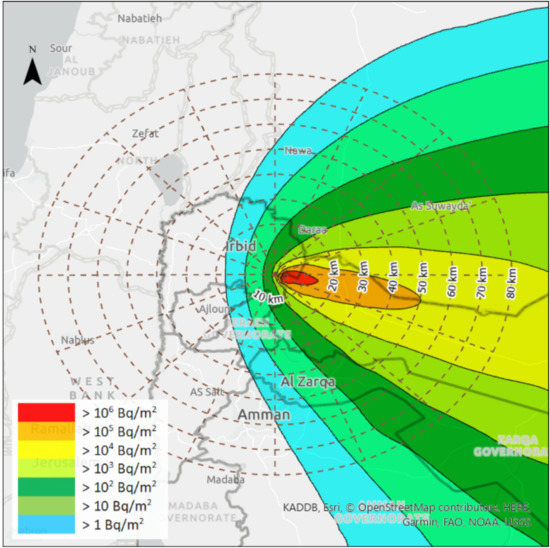
Figure 4.
Total ground deposition for the whole month of July 2013.

Figure 5.
Total ground deposition for the whole month of January 2014.
The calculated monthly dose, which accounts for the internal and external doses, as presented in Equations (1)–(3), is shown in Figure 6 and Figure 7. The maximum dose for the whole month of July 2013 was estimated to be approximately 3.6 × 101 mSv at a radius of 5 km from the JRTR, whereas the minimum dose was approximately 2.6 × 10−7 mSv at a radius of 80 km from the JRTR. The maximum and minimum doses in January 2014 were estimated to be approximately 5.0 × 101 mSv and 4.9 × 10−5 mSv. As mentioned previously, January has relatively high humidity and precipitation; therefore, a large amount of radioactive material is deposited and high dose rates occur near the JRTR.
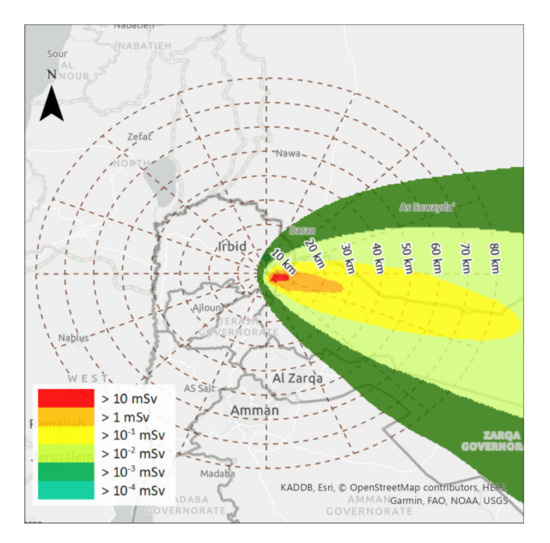
Figure 6.
Total dose received in July 2013.
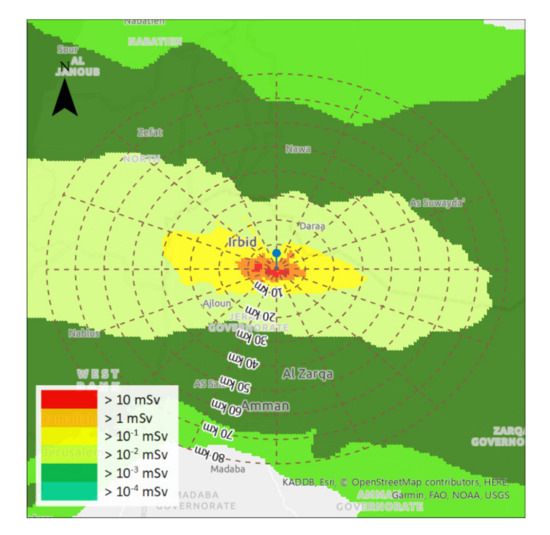
Figure 7.
Total dose received in January 2014.
The thyroid dose by inhalation and deposition was estimated for the three age groups by using the calculated air concentrations and ground depositions in July 2013 and January 2014. The maximum monthly thyroid doses were 80 mSv, 62 mSv and 40 mSv at a radius of 5 km from the JRTR for 1-year old infants, 10-year old children, and adults in July 2013. In addition, they showed 110 mSv, 86 mSv and 55 mSv for 1-year old infants, 10-year old children, and adults in January 2014.
According to Figure 6, although a dose of 1 mSv was calculated more than 20 km to the east of the JRTR site, the affected areas consist of low populated lands, with only a few small communities located within this region. With the exception of the Mafraq governorate, all other governorates received a minimal dose of less than 0.1 mSv. Figure 7 shows that the dose in the area within a 10 km radius of the JRTR site exceeds 1 mSv, impacting the Bani Obeid district, but posing no significant danger to the densely populated Irbid Qasabah district or other districts in the Irbid governorate. Some areas in the Irbid and Mafraq governorates are estimated to receive a dose greater than 1 mSv, while all other governorates receive a very low dose of less than 0.1 mSv. Both Figure 6 and Figure 7 show that even if a severe accident was to damage the JRTR confinement and core, only a limited area is estimated to be at significant risk of high exposure to radioactive materials. Densely populated cities and regions are estimated to receive a minimal dose.
The aforementioned estimated doses were calculated without considering any protective measures. Consequently, if appropriate protective actions are implemented, the doses are expected to decrease substantially. The radiological effects on people living near the JRTR differed depending on the air and deposition concentrations in their local areas, which varied according to meteorological conditions. Individuals residing in the eastern area of the JRTR presented high radiological risks in July, while some individuals living in the western and eastern areas of the JRTR faced high risks in January. In this regard, developing a protective plan for people in each direction for a nuclear accident could minimize the radiological risks.
In this study, the maximum dose was estimated to be 50 mSv for the month of January, approximately 5 km away from the JRTR site. This value, when compared to the JRTR Final Safety Analysis Report (FSAR) [3], was found to be reached at approximately 120 m from the JRTR site after 30 days of an accidental release. It should be noted that the JRTR source term in the FSAR was calculated based on only one fuel assembly meltdown. Conversely, Xoubi [10] estimated that the total effective dose of 50 mSv could be reached for a distance of more than 10 km, depending on the Pasquil stability class, with the maximum dose of approximately 200 Sv for most stability classes. This significant difference in total effective dose values is attributed to several parameters that have a significant impact on radiological hazard assessment, such as the source term, meteorological conditions, and dispersion models used for risk hazard assessment.
4. Conclusions
To mitigate the environmental and health risks of nuclear accidents, effective emergency response plans must be established. These plans should encompass the establishment of evacuation routes and zones, communication systems, and emergency shelters. Furthermore, educational programs should be conducted to raise public awareness about the potential health and safety risks associated with nuclear accidents.
In this study, numerical simulations were performed for the summer and winter seasons to estimate the occurrence of relatively high and low radiological effects near the JRTR. A higher dose was estimated in winter than in summer owing to meteorological conditions, such as humidity, precipitation, and wind patterns. However, even if we assumed that the maximum calculated dose in winter or summer was sustained for one year, the expected annual dose for densely populated areas would be below the annual limit for the public. Consequently, even in the event of a severe nuclear accident in the JRTR, the radiological risks for people residing in nearby cities are considerably low.
To ensure safe operation and maintenance of nuclear facilities, safety regulations and standards should be established and enforced. Furthermore, effective emergency response plans must be organized to provide technical assistance for the safe operation of nuclear facilities. By implementing these measures, the potential risks of nuclear accidents can be minimized, thereby promoting the overall safety and well-being of the general public.
Author Contributions
Conceptualization, M.T. and K.-S.S.; methodology, M.T. and K.-S.S.; software, M.T.; validation, M.T. and S.K.; formal analysis; M.T., S.K. and K.-S.S.; resources, M.T. and K.-S.S.; data curation, M.T., S.K. and K.-S.S.; writing—original draft preparations, M.T., S.K. and K.-S.S.; writing—review and editing, M.T. and K.-S.S.; visualization, M.T.; supervision, K.-S.S.; project administration, S.K. and K.-S.S.; funding acquisition, S.K. and K.-S.S.; investigation, M.T., S.K. and K.-S.S. All authors have read and agreed to the published version of the manuscript.
Funding
This research was supported by a National Research Foundation of Korea (NRF) grant funded by the Korean government (Ministry of Science and ICT (RS-2023-00144350)), the research program of the Korea Atomic Energy Research Institute, and the Korea Research Environment Open NET-work (KREONET).
Institutional Review Board Statement
Not applicable.
Informed Consent Statement
Not applicable.
Data Availability Statement
Not applicable.
Conflicts of Interest
The authors declare no conflict of interest.
References
- Suh, K.S.; Han, M.H.; Jung, S.H.; Lee, C.W. Three-dimensional numerical modeling of pollutant transport at local-scale complex terrain. Ann. Nucl. 2008, 35, 1016–1023. [Google Scholar] [CrossRef]
- Jawerth, N.; Mattar, E. Exploring research reactors and their use. IAEA Bull. Res. React. 2019, 60–64, 4–5. [Google Scholar]
- Korea Atomic Energy Research Institute. Jordan Research and Training Reactor Final Safety Analysis Report; Korea Atomic Energy Research Institute: Daejeon, Republic of Korea, 2016. [Google Scholar]
- Xoubi, N. Jordan’s First Research Reactor Project: Driving Forces, Present Status and the Way Ahead. In Proceedings of the European Research Reactor Conference, Rome, Italy, 20–24 March 2011; pp. 26–30. [Google Scholar]
- Kim, K.-O.; Jun, B.J.; Lee, B.; Park, S.-J.; Roh, G. Comparison of first criticality prediction and experiment of the Jordan research and training reactor (JRTR). Nucl. Eng. Technol. 2020, 52, 14–18. [Google Scholar] [CrossRef]
- IAEA. Derivation of the Source Term and Analysis of the Radiological Consequences of Research Reactor Accidents, Safety Reports Series No. 53; IAEA: Vienna, Austria, 2008. [Google Scholar]
- IAEA. Preparedness and Response for a Nuclear or Radiological Emergency, Safety Standards Series No. GSR Part 7; IAEA: Vienna, Austria, 2015. [Google Scholar]
- IAEA. Criteria for Use in Preparedness and Response for a Nuclear or Radiological Emergency, Safety Standards Series No. GSG-2; IAEA: Vienna, Austria, 2011. [Google Scholar]
- Korea Atomic Energy Research Institute. Jordan Research and Training Reactor Radiation Environmental Report; Korea Atomic Energy Research Institute: Daejeon, Republic of Korea, 2015. [Google Scholar]
- Xoubi, N. Source term derivation and radioactive release evaluation for JRTR research reactor under severe accident. Sci. Technol. Nucl. Install. 2020, 2020, 1868965. [Google Scholar] [CrossRef]
- Homann, S.G.; Aluzzi, F. HotSpot Health Physics Codes Version 3.1.2 User’s Guide; Lawrence Livermore National Laboratory: Livermore, CA, USA, 2020. [Google Scholar]
- Till, J.E.; Grogan, H. Radiological Risk Assessment and Environmental Analysis; Oxford University Press: Oxford, UK, 2008. [Google Scholar]
- Raúl, P.; Kathleen, M.T.; Sohan, L.C.; Francesco, M.; Emilie, N.; Gert, S.; Dejan, T. Mid-range atmospheric dispersion modelling. Intercomparison of simple models in EMRAS-2 project. J. Environ. Radioact. 2016, 162–163, 225–234. [Google Scholar] [CrossRef]
- Periáñez, R.; Bezhenar, R.; Brovchenko, I.; Duffa, C.; Iosjpe, M.; Jung, K.T.; Kim, K.O.; Kobayashi, T.; Liptak, L.; Little, A.; et al. Marine radionuclide transport modelling: Recent developments, problems and challenges. Environ. Model. Softw. 2019, 122, 104523. [Google Scholar] [CrossRef]
- Stein, A.F.; Draxler, R.R.; Rolph, G.D.; Stunder, B.J.B.; Cohen, M.D.; Ngan, F. NOAA’s HYSPLIT atmospheric transport and dispersion modeling system. Bull. Amer. Meteor. Soc. 2015, 96, 2059–2077. [Google Scholar] [CrossRef]
- Jordan Department of Statistics. Jordan Estimated Population of 2022; Jordan Department of Statistics: Amman, Jordan, 2023. [Google Scholar]
- Jordan Department of Statistics. Jordan Statistical Yearbook 2013; Jordan Department of Statistics: Amman, Jordan, 2013. [Google Scholar]
- Draxler, R.R. HYSPLIT4 User’s Guide; NOAA Technical Memorandum ERL ARL-230; NOAA Air Resources Laboratory: Silver Spring, MD, USA, 1999. [Google Scholar]
- Draxler, R.; Hess, G. An overview of the HYSPLIT_4 modelling system for trajectories. Aust. Meteorol. Mag. 1998, 47, 295–308. [Google Scholar]
- Draxler, R.R.; Hess, G. Description of the HYSPLIT4 Modeling System; NOAA Tech. Memo. ERL ARL-224; NOAA Air Resources Laboratory: Silver Spring, MD, USA, 1997; p. 24. [Google Scholar]
- Takahara, S.; Iijima, M.; Watanabe, M. Assessment Model of Radiation Doses from External Exposure to the Public after the Fukushima Daiichi Nuclear Power Plant Accident. Health Phys. 2020, 118, 664–677. [Google Scholar] [CrossRef] [PubMed]
- UNSCEAR. Methodology for Estimating Human Exposures Due to Radioactive Discharges; UNSCEAR: Vienna, Austria, 2013. [Google Scholar]
- ICRP. Age-dependent dose to members of the public from intake of radionuclides: Part 5 compilation of ingestion and inhalation dose coefficients. Ann. ICRP 1996, 26, 1–91. [Google Scholar] [CrossRef] [PubMed]
- ICRP. Human respiratory tract model for radiological protection. Ann. ICRP 1994, 24, 1–482. [Google Scholar] [CrossRef]
- ICRP. Age-dependent doses to members of the public from intake of radionuclides: Part 4 Inhalation dose coefficients. Ann. ICRP 1995, 25, 1–402. [Google Scholar] [CrossRef]
- Eckerman, K.F.; Ryman, J.C. Federal Guidance Report No. 12: External Exposure to Radionuclides in Air, Water, and Soil; U.S. Environmental Protection Agency: Washington, DC, USA, 1993. [Google Scholar]
- Eckerman, K.F.; Wolbarst, A.B.; Rischardson, A.C.B. Federal Guidance Report No. 11: Limiting Values of Radionuclide Intake and Air Concentration and Dose Conversion Factors for Inhalation, Submersion, and Ingestion; U.S. Environmental Protection Agency: Washington, DC, USA, 1988. [Google Scholar]
- Draxler, R.; Stunder, B.; Rolph, G.; Stein, A.; Taylor, A.; Zinn, S.; Loughner, C.; Crawford, A. HYSPLIT User’s Guide; NOAA Air Resources Laboratory: Silver Spring, MD, USA, 2022. [Google Scholar]
Disclaimer/Publisher’s Note: The statements, opinions and data contained in all publications are solely those of the individual author(s) and contributor(s) and not of MDPI and/or the editor(s). MDPI and/or the editor(s) disclaim responsibility for any injury to people or property resulting from any ideas, methods, instructions or products referred to in the content. |
© 2023 by the authors. Licensee MDPI, Basel, Switzerland. This article is an open access article distributed under the terms and conditions of the Creative Commons Attribution (CC BY) license (https://creativecommons.org/licenses/by/4.0/).